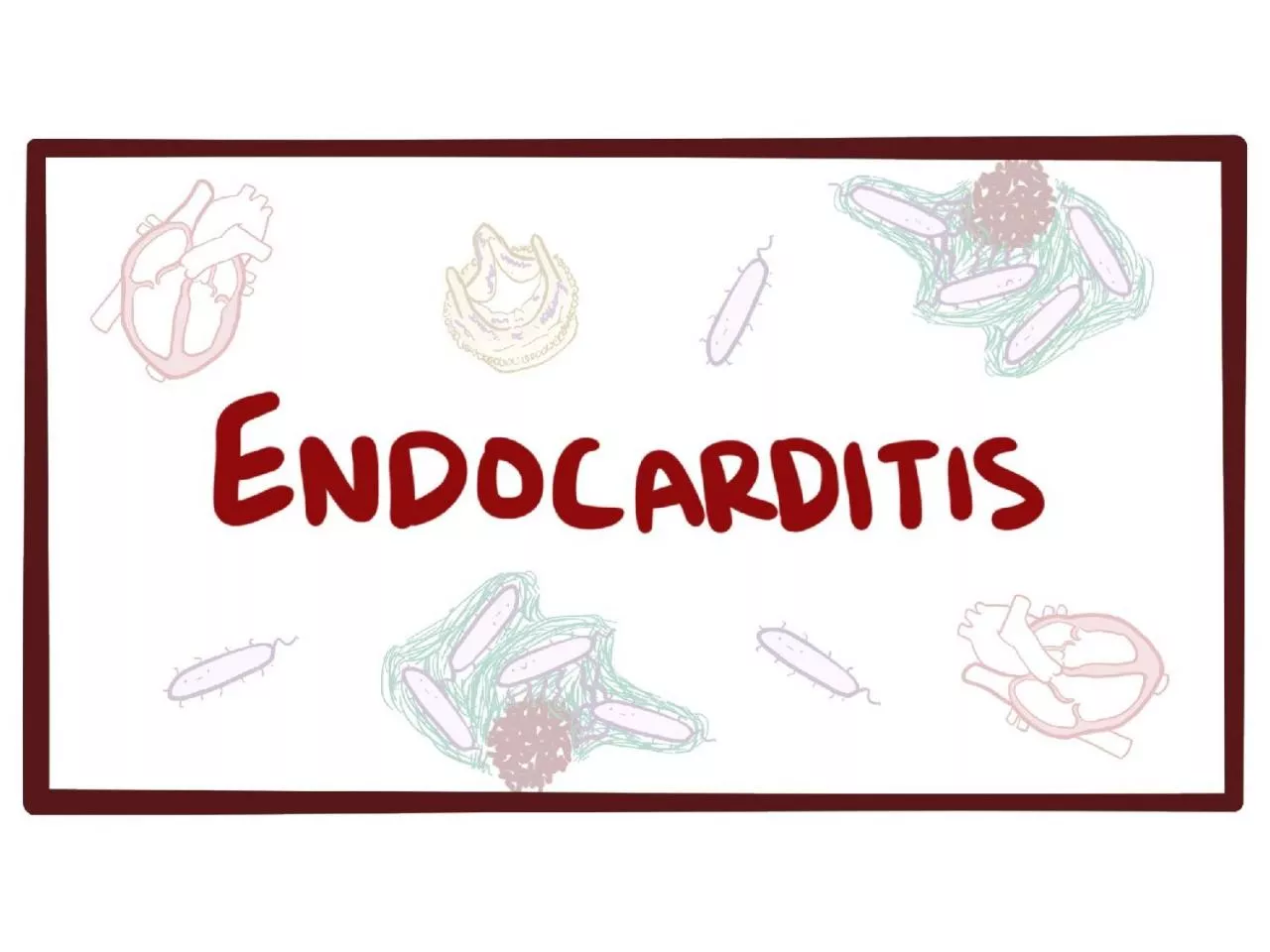

endocardium the membrane lining the chambers of the heart and covering the cusps of the heart valves Infective endocarditis IE refers to infection of the heart valves by microorganisms primarily bacteria ID: 932419
Download Presentation The PPT/PDF document "Endocarditis is an inflammation of the" is the property of its rightful owner. Permission is granted to download and print the materials on this web site for personal, non-commercial use only, and to display it on your personal computer provided you do not modify the materials and that you retain all copyright notices contained in the materials. By downloading content from our website, you accept the terms of this agreement.
Slide1
Slide2Endocarditis
is an inflammation of the
endocardium
, the membrane lining the chambers of the heart and covering the cusps of the heart valves.
Infective
endocarditis
(IE) refers to infection of the heart valves by microorganisms,
primarily bacteria.
Slide3Slide4Slide5Risk Factors
Presence of a prosthetic valve (highest risk)
✓ Previous
endocarditis
(highest risk)
✓ Complex cyanotic congenital heart disease (e.g., single ventricle states)
✓ Surgically constructed systemic pulmonary shunts or conduits
✓ Acquired
valvular
dysfunction (e.g., rheumatic heart disease)
✓ Hypertrophic
cardiomyopathy
✓ Mitral valve
prolapse
with regurgitation
✓ IV drug abuse
Slide6Causative organisms
Slide7Factors associated with increased mortality include the following:
Congestive heart failure
✓Culture-negative
endocarditis
✓
Endocarditis
caused by resistant organisms such as fungi and gram negative bacteria
✓Left-sided
endocarditis
caused by
S.
aureus
✓Prosthetic valve
endocarditis
(PVE)
Slide8CLINICAL PRESENTATION
Symptoms
The patient may complain of fever, chills, weakness,
dyspnea
, night sweats, weight loss, and/or malaise.
Signs
Fever is common as well as a heart murmur (sometimes new or changing). The patient may or may not
have embolic phenomenon,
splenomegaly
, or skin manifestations (e.g., Osler’s nodes,
Janeway
lesions).
Slide9Laboratory tests
white blood cell count-
--- may be normal or only slightly elevated.
Nonspecific findings include
anemia (
normocytic
,
normochromic
),
thrombocytopenia,
elevated erythrocyte sedimentation rate (ESR)elevated C-reactive protein, and
altered urinary analysis (
proteinuria
/microscopic
hematuria
).
The hallmark laboratory finding is continuous
bacteremia
; three sets of blood cultures should be collected over 24 hours.
Slide10Other diagnostic tests
An electrocardiogram,
chest radiograph,
Echocardiogram
Echocardiography to determine the presence of
valvular
vegetations; it should be performed in all suspected cases.
Slide11Slide12DESIRED OUTCOME
• Relieve the signs and symptoms of disease.
• Decrease morbidity and mortality associated with infection.
• Eradicate the causative organism with minimal drug exposure.
• Provide cost-effective antimicrobial therapy.
• Prevent IE in high-risk patients with appropriate prophylactic antimicrobials.
Slide13TREATMENT
Treatment usually is started in the hospital, but in selected patients, it may be completed in the outpatient setting.
• Large doses of
parenteral
antimicrobials usually are necessary.
• An extended duration of therapy is required,
Surgery is an important adjunct to management of
endocarditis
in certain patients.
Slide14STREPTOCOCCAL ENDOCARDITIS
Streptococci are a common cause of IE, with most isolates being
viridans
streptococci.
Slide15The following conditions should all be present to consider a 2-week treatment regimen:
✓ The isolate is penicillin sensitive (MIC less than or equal to 0.1 mcg/
mL
).
✓ There are no cardiovascular risk factors such as heart failure, aortic insufficiency, or conduction abnormalities.
✓ No evidence of thrombotic disease.
✓ Native valve infection.
✓ No vegetation greater than 5 mm diameter.
✓ Clinical response is evident within 7 days.
Slide16STAPHYLOCOCCAL ENDOCARDITIS
S.
aureus
has become more prevalent as a cause of
endocarditis
because of
increased IV drug abuse,
frequent use of peripheral and central venous catheters,
valve-replacement surgery.
(represent 60%-8-% of
s.aureus
)
Slide17Treatment of
Staphylococcus
Endocarditis
in IV Drug Abusers
Slide18Treatment of Staphylococcal Prosthetic Valve
Endocarditis
• PVE that occurs within 2 months of cardiac surgery is usually caused by staphylococci implanted at the time of surgery.
Methicillin
-resistant organisms are common
.
Vancomycin
is the cornerstone of therapy.
• Because of the high morbidity and mortality associated with,
combinations
of antimicrobials are usually recommended.
Slide19ENTEROCOCCAL ENDOCARDITIS
Enterococci
cause 5% to 18% of
endocarditis
cases.
no single antibiotic is bactericidal;
MICs to penicillin are relatively high (1 to 25 mcg/
mL
);
they are intrinsically resistant to all
cephalosporins
and relatively resistant to
aminoglycosides
(4) combinations of a cell wall–active agent, such as a penicillin or
vancomycin
, plus an
aminoglycoside
are
necessary for killing;
(5) resistance to all available drugs is increasing.
Slide20ENTEROCOCCAL ENDOCARDITIS
Slide21EVALUATION OF THERAPEUTIC OUTCOMES
includes assessment of signs and symptoms,
blood cultures,
microbiologic tests,
serum drug concentrations,
other tests to evaluate organ function.
Persistence of fever beyond 1 week indicate ineffective antimicrobial,
blood cultures should be negative within a few days…
Slide22PREVENTION OF ENDOCARDITIS
Antimicrobial prophylaxis is used to prevent IE in patients believed to be at high risk.
Endocarditis
prophylaxis is recommended for all dental procedures
Slide23Slide24GOOD LUCK